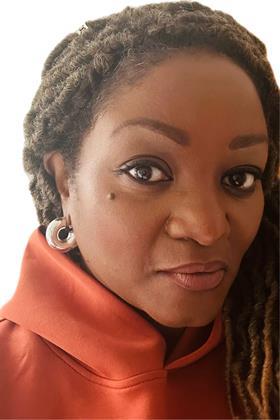A data-led approach was the starting point for an expansive new ‘Equity by Design’ strategy that seeks to advance inclusion and diversity both behind the camera and on-screen, writes David Davies.
Although Channel 4 has long been in the vanguard of broadcast organisations working to effect positive change in the industry, there was no doubting the significance of Marcia Williams’ appointment as its first-ever Director of Inclusion in August 2022.

Arriving at the channel with nearly three decades’ experience in senior diversity and inclusion (D&I) roles at organisations including TfL, UK Film Council and HM Treasury, Williams’ immediate priorities included the development of a new strategy designed to ensure that Channel 4 “continues to foster an inclusive workplace culture and remains at the forefront of [D&I] in the UK”, to quote the press announcement.
The resulting document, Equity by Design, was published at the end of March 2024 and is built around six principles informed by employee, audience and stakeholder feedback, namely: make informed choices; design for inclusion; choose inclusive partners; treat people right; create opportunity; and lead on societal impact.
The strategy provided the basis for a far-reaching IBC365 interview with Williams that also touched on Channel 4’s existing diversity practices, the looming technical skills crisis, and some of the recent landmark series – including It’s A Sin and Defiance: Fighting the Far Right – that exemplify the broadcaster’s objectives on-screen.
START WITH THE DATA
Invited to assess the scale of the challenge as she perceived it at the time of her appointment nearly two years ago, Williams says: “My approach is always to start with the data, and fortunately [Channel 4] has got good systems internally in terms of helping people to self-identify and [collecting] fully diverse information. That’s critical because it gives you a sense as a practitioner of how comfortable people are with sharing information about themselves, so it’s a good sign to see well-completed, accurate information; and it also gives you some ideas about areas you could start to examine more closely.”

Several existing initiatives, including regular surveys and “listening sessions”, provided useful starting points for further action. Practical action, it is clear, underpins Williams’ entire philosophy: “I do think there are lots of organisations who believe that if you address diversity then it will come about almost by osmosis, you will have all of these positive things like different and better connections to audiences, and different and better team working. But I’ve been doing this work for nearly 30 years, and it doesn’t happen automatically.”
Read more Power of Color Symposium 2024: Flesh tones, shooting open gate, and AI in post
Pursuing a mindful approach to D&I and its implementation on a “day-to-day level” makes Equity by Design a fitting title for the new strategy. “You do have to be consciously inclusive and really plan, and be designed for, inclusion – and also minimise the items that you have to go back to and almost ‘retrofit’ for inclusion,” says Williams. “So by calling it Equity by Design we can signal that slight step-change about how we are going to put it into the way we think, the way we develop products, and the way our office is going forward.”
IBC365 was keen to explore several of the principles in more detail, beginning with ‘choose inclusive partners,’ which calls for a focus on “investing in diverse, inclusive partners who share Channel 4’s values, while passing learnings and expertise on to others.” In a fairly fragmented broadcast landscape, how can this be most effectively applied to the selection of production and technical partners?
“One thing is obviously to communicate what we’re doing and what our intention is, which includes being the first public digital streamer that is producing content that really does speak to other voices and creates change through entertainment,” says Williams. “Getting that really well-communicated helps massively because in a sense, companies are self-selecting into that; they’re choosing to be a part of it by bringing their content to us. But one of the other ways we can achieve this is through our commissioning guidelines, which mean we communicate really clear expectations about where we would like to see diversity behind the camera and on-screen.”
This may include the identification of aspects where “reasonable workplace adjustments” can be made, always bearing in mind the principle that “because [changes] might attract a cost element should not be a reason to not go down that route.”
Invited to consider the current outlook for D&I in the UK’s production sector, Williams points to multiple industry reports showing that there “has been progress, but not necessarily uniform progress. There are some characteristics that are less well-developed, so for example disability portrayal has been one of those areas that’s been incredibly difficult to really shift across the industry as a whole, whether that’s off-screen or on-screen talent, or portrayals within programmes. So that’s an example of why, if overall we’re making good progress, we always need to stay vigilant around some specific characteristics.”
SOCIETAL IMPACT
One of the principles on which Channel 4 had arguably made the most significant progress prior to the crystallisation of the new strategy is ‘lead on societal impact’. This calls for sustained action on “emerging societal issues affecting employees and audiences, tackling topics others shy away from,” as well as the creation of space for “meaningful conversation about complex, nuanced topics, including the ongoing conflict and crisis in Israel and Gaza.”

In addressing a chapter of history whose themes of politically-inflamed community divisions and systemic police misconduct sadly feel as resonant in 2024 as they were in the late 1970s, the superb recent Rogan Productions series for Channel 4, Defiance: Fighting the Far Right – which explores how Britain’s Asian community was targeted with a campaign of violence and murder as the National Front rose to prominence – is surely in keeping with this principle.
“It is a really good example,” agrees Williams, “and it was very exciting to be at the launch a few weeks ago at Whitechapel Gallery in the heart of that community [in London’s East End] listening to actors, in every sense of that word, who were at the frontline of some of those events. It was incredibly powerful. Also, these programmes are not made in a vacuum; although we might be looking back at events that happened many years ago, the relevance to things now is really pertinent.”
A look at the social media debate following the original transmission of Defiance suggests its impact has been significant. Moreover, measuring the long-term influence of its programming is an area where Channel 4 has excelled for some time. For example, Davina McCall’s acclaimed documentaries about the menopause led to a huge increase in women enquiring about HRT prescriptions to help manage the symptoms. Meanwhile, It’s a Sin – Russell T Davies’ drama depicting the lives of a group of gay men and their friends during the HIV/AIDS crisis, which is now Channel 4’s most-watched drama series ever – prompted a massive surge in HIV testing when it aired during National HIV Testing Week, with Terrence Higgins Trust reporting that the number of first-day test orders was four times the previous record.
Upcoming highlights will include a continuation of Channel 4’s BAFTA Award-winning coverage of the Paralympics. Programming from this year’s Paralympic Games – which takes place in Paris from 28 August to 8 September – will be produced by independent company Whisper, which won the tender after demonstrating “innovative and creative plans” to build upon the channel’s coverage of previous Paralympics. In addition, a Paralympic Production Training Scheme announced by Channel 4 in spring 2023 has given 19 disabled people the chance to launch their broadcast careers with 12-month placements at independent production companies across the UK – with some then going on to work at the Games in Paris.
“The Paralympics is always a really impactful way to sort of test and also push social attitudes around disability,” says Williams, noting that previous events have generated “award-winning campaigns around the ads, and incredible portrayals of sports and athletes. The work that has been done around rostering disabled talent for the programming itself is also really powerful.”
More generally, Williams is acutely aware of the technical skills shortages now threatening many areas of broadcast & media, and reveals that development of “local equity plans” – including more outreach to schools and colleges regarding the myriad of opportunities that exist behind the camera – is currently in progress. “There is a huge amount of work taking place in that space,” she confirms.
CHALLENGING TIMES
It hardly needs stating that all of this takes place against a highly challenging period for UK broadcasting. Although Channel 4 unveiled a new five-year strategy in January 2024 that will see it become a ‘digital-first public streamer’ by 2030, it still has to contend with the long-term industry decline in linear advertising. The strategy also acknowledges the need for some tough decisions, including a proposed 18% reduction in headcount, the closure of “small linear channels” delivering insufficient revenue, and a move out of the channel’s current London base “in the next few years”. Simultaneously, the societal divisions and culture wars that seem to have become so much more acute in recent years present major existential challenges to channel executives and programme-makers.

As Williams observes, it’s very much a two-sided story. “On one hand, there has been incredible progress in the last 15 years with [developments like the 2010] Equality Act broadening the idea of what is discriminatory behaviour and giving more access to rights for more people,” she says. “But also, the kind of culture wars and notions of wokery, anti-wokery and anti-anti-wokery have made it really difficult to talk about some of these issues confidently and straightforwardly, and to really focus on the disadvantage that people are trying to address.”
If the broader context is “increasingly challenging”, then it can also be perceived as further validation of the principles embedded in Equity by Design. “In one sense it does help you to double-down and focus on what is really important and who are we doing it for,” confirms Williams. “Ultimately, you’re doing it to make working lives better for people, and [as a consequence] bring in people who can commission, make and support exactly the kinds of programmes you’re talking about. With this strategy, we now have a really strong framework for tracking and measuring our progress over time, and one that we can also tweak and course-correct when we need to.”
Channel 4’s Equity by Design strategy can be downloaded in full here.
Read more Inclusion begins in the writers’ room
























No comments yet